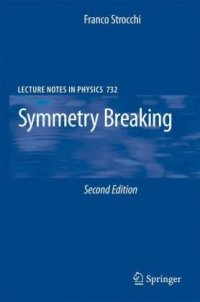
Ebook: Symmetry Breaking
Author: Franco Strocchi (auth.)
- Genre: Mathematics // Symmetry and group
- Tags: Mathematical Methods in Physics, Elementary Particles Quantum Field Theory, Topological Groups Lie Groups, Quantum Field Theories String Theory, Quantum Physics
- Series: Lecture notes in physics 732
- Year: 2008
- Publisher: Springer-Verlag Berlin Heidelberg
- City: Berlin; New York
- Edition: 2
- Language: English
- djvu
This new edition of Prof. Strocchi's well received primer on rigorous aspects of symmetry breaking presents a more detailed and thorough discussion of the mechanism of symmetry breaking in classical field theory in relation with the Noether theorem. Moreover, the link between symmetry breaking without massless Goldstone bosons in Coulomb systems and in gauge theories is made more explicit in terms of the delocalized Coulomb dynamics. Furthermore, the chapter on the Higgs mechanism has been significantly expanded with a non-perturbative treatment of the Higgs phenomenon, at the basis of the standard model of particle physics, in the local and in the Coulomb gauges. Last but not least, a subject index has been added and a number of misprints have been corrected. From the reviews of the first edition:
The notion of spontaneous symmetry breaking has proven extremely valuable, the problem is that most derivations are perturbative and heuristic. Yet mathematically precise versions do exist, but are not widely known. It is precisely the aim of his book to correct this unbalance. - It is remarkable to see how much material can actually be presented in a rigorous way (incidentally, many of the results presented are due to Strocchi himself), yet this is largely ignored, the original heuristic derivations being, as a rule, more popular. - At each step he strongly emphasizes the physical meaning and motivation of the various notions introduced [...] a book that fills a conspicuous gap in the literature, and does it rather well. It could also be a good basis for a graduate course in mathematical physics. It can be recommended to physicists as well and, of course, for physics/mathematics libraries. J.-P. Antoine, Physicalia 28/2, 2006
Strocchi's main emphasis is on the fact that the loss of symmetric behaviour requires both the non-symmetric ground states and the infinite extension of the system. It is written in a pleasant style at a level suitable for graduate students in theoretical physics. While mathematically proper, it is not forbidding for a physics readership; the author is always aware this subject is a branch of physics. It should make profitable reading for many theoretical physicists.
L.H. Ryder, J. Phys. A, 38 (2005) 9719-9730
In these notes the author explores the phenomenon of spontaneous symmetry breaking as it arises in classical and quantum systems. Despite many accounts in popular textbooks and a widespread belief, the phenomenon is rather subtle, requires an infinite set of degrees of freedom and an advanced mathematical setting of the system under investigation. [...] The mathematically oriented graduate student will certainly benefit from this thorough, rigorous and detailed investigation. G. Roepstorff, Zentralblatt MATH, Vol. 1075, 2006
Spontaneous symmetry breaking is a revolutionary new idea of thinking in terms of symmetry and the corresponding properties of physical systems. The first part of this book develops the mathematical understanding of spontaneous symmetry breaking on the basis of classical field theory. The author addresses the existence of sectors, stability, and presents an improved Noether theorem, as well as the classical counterpart of the Goldstone theorem. The second part deals with quantum systems. Here criteria for spontaneous symmetry breaking are discussed in detail as well as Goldstone's theorem, gauge theories are included, and the theorem on the Higgs mechanism is presented. The author keeps the mathematical details to the minimum required to make the book accessible to students with basic knowledge of Hilbert space structures. Much of the material appears here for the first time in book form.